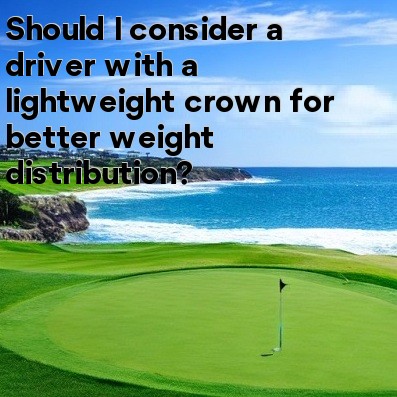
In golf, Should I consider a driver with a lightweight crown for better weight distribution?
When it comes to choosing a driver for your golf game, there are several factors to consider. One of those factors is the weight distribution of the driver, particularly in the clubhead. The crown, or top of the driver, plays a significant role in this weight distribution. Many golfers wonder if opting for a driver with a lightweight crown can improve their performance on the course. Let's dive deeper into this topic.
- Weight distribution: Weight distribution in the clubhead can affect your swing, launch angle, and overall distance. A driver with a low center of gravity (CG) and optimal weight distribution can help maximize distance and forgiveness.
- Importance of the crown: The crown of a driver is typically made from various materials such as titanium, carbon fiber, or a combination of both. It not only provides structural support but also affects the weight distribution of the clubhead.
- Advantages of a lightweight crown: A driver with a lightweight crown allows manufacturers to redistribute weight to other areas, such as the lower back of the clubhead. This can lower the CG, increase moment of inertia (MOI), and optimize the launch conditions. These factors can result in improved clubhead speed, higher launch, and increased distance.
- Increased clubhead speed: With a lightweight crown, you may experience improved clubhead speed due to the redistribution of weight. This can help generate more distance off the tee and increase your chances of hitting longer drives.
- Higher launch: A driver with a low CG, achieved through a lightweight crown, promotes a higher launch angle. Higher launch angles can create more carry distance and allow the ball to stop quicker on the greens.
- Increased forgiveness: Optimal weight distribution, facilitated by a lightweight crown, enhances the club's MOI. Higher MOI provides more forgiveness on off-center hits by reducing the amount of twisting or torque at impact. This can help correct mishits and keep the ball in play.
While a lightweight crown can offer advantages, it's important to note that it's not the only factor to consider when selecting a driver. Each golfer's swing characteristics, skill level, and personal preferences should also be taken into account.
Drawbacks of a lightweight crown:
- Sound and feel: Some golfers prefer the solid and muted sound produced by a driver with a heavier crown. A lightweight crown might result in a different feel and sound at impact, which can affect overall confidence and satisfaction.
- Cost: Drivers with lightweight crowns often use advanced materials or technologies, which can increase the price. Prioritize your budget and determine if the potential benefits outweigh the additional cost.
- Individual preference: Every golfer has different preferences when it comes to equipment. It's essential to try different drivers and assess your own performance and comfort.
In summary, a driver with a lightweight crown can offer advantages such as improved weight distribution, increased clubhead speed, higher launch, and increased forgiveness. However, the sound and feel might differ from drivers with heavier crowns, and the cost can be higher. Ultimately, selecting the right driver should be based on a combination of factors, including individual swing characteristics, personal preference, and budget.





